 R. metternichii
R. metternichii
 R. metternichii
R. metternichii
Closely related to R. metternichii are two other Japanese species which I count among my favorites, R. makinoi and R. yakushimanum . Makinoi is a striking foliage plant, with very narrow leaves sometimes measuring over 5 inches long but usually less than 1/2 inch wide. The foliage is heavily indumented, and the new growth makes a commanding landscape statement throughout most of the summer. At first, the new shoots look like fuzzy white candles as they emerge in June. Gradually, the color changes to tan as the growth expands during July and August. Eventually, the fuzz on the upper surface of the leaf rubs off exposing a deep green leaf surface beneath, but the fuzzy tan indumentum remains on the underside of the leaves. The light colored whorls of narrow pointed leaves which contrast against the deep green foliage from previous years reminds me of a 4th of July fireworks display. I have raised several makinoi plants from seed as well as cuttings. My best plant is rather compact even though it is growing in rather deep shade and measures only 3 feet high by 4 feet wide in 25 years. I raised this plant from seed obtained in the ARS seed exchange. The flowers of most of my makinoi plants are deep pink and appear in early May, although there are clones which are blush pink to near white.
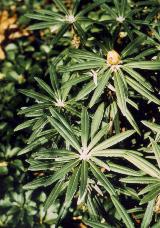
|
 R. makinoi flowers A nice pink form raised from seed |
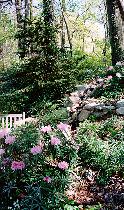 R. makinoi plant near my waterfall. |
|
R. makinoi plant Long narrow foliage. |
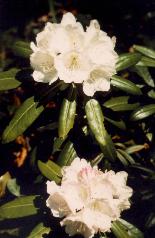
|

|
|
A form of R. yakushimanum |
An excellent dwarf rhododendron. |
I have raised many seedlings of primary yak crosses, and I especially like the cross (yakushimanum x R. metternichii) which produces uniformly compact plants with glossy leaves and blush pink to white flowers. These plants are exceptionally rugged, and have survived drought, heat, and cold. Seedlings have rolled around in pots in my back yard for years before I finally decided to give them a home. Another cross with an interesting foliage effect is (Yaku Angel x makinoi) whose plants have deep green narrow leaves, intermediate between the two parents. The flowers are pink in bud fading to white as the blossoms open, which is generally true for most primary yakushimanum crosses. Pale flower color is dominant in yakushimanum hybrids, but I am partial to white so I don't mind. Excellent foliage is dominant too.
China has so many superb rhododendron species that it is impossible to do them justice in a short article. Most of our modern hybrids, especially those with large flowers and strong colors have been developed from the wealth of species found in China. I have tried raising many exotic Chinese species, such as the yellow R. wardii, red R. griersonianum, and blue R. augustinii, but our winters are usually too cold and our summers too hot. The plants usually succumb to bark split, dieback, and disease problems. However, hybrids of these delicate sorts when crossed with hardier species are often very successful in our area. Perhaps the most adaptable Chinese rhododendron species and a proven parent for hybridizing here in the eastern United States is Rhododendron fortunei. It was named for plant explorer Robert Fortune who introduced the species in 1856. Fortunei is a tall grower with large leaves and large fragrant flowers which are usually pale lavender to near white. The plant is both cold hardy in our region as well as heat tolerant. This species is considered a likely parent of many of the Dexter rhododendrons, and seems to impart both large flower size and reasonable hardiness to its progeny. In contrast to the color dominance of R. yakushimanum, R. fortunei allows other colors to take precedence over the less desirable lavender tones. For instance, the best yellow rhododendron in my yard is the hybrid "Golden Star", a cross of R. croceum (considered a form of R. wardii) with R. fortunei. Given a moist but well drained location, this hybrid developed by Donald Hardgrove on Long Island has proven very reliable for me.
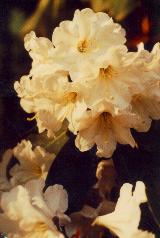
|
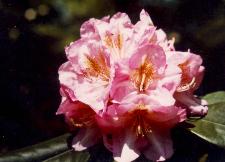
|
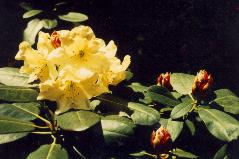
|
|
A hardy species from China. |
A Dexter hybrid |
A Hardgrove hybrid |